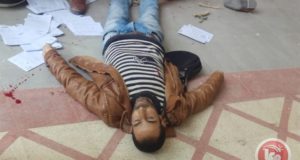August 11 | International Solidarity Movement | Hebron, occupied Palestine Yesterday in Tel Rumeida, the afternoon before Eid, settlers attacked an elderly Palestinian couple as they walked home. International activists in the area attempted to document the abuse. The soldiers ...
Read More »Water Series: IOF destroy farmland east of Hebron – ISM speaks to owner Ghassan Jaber
July 30 2019 | International Solidarity Movement | Bit Arawa, occupied Palestine This is the first of a series of reports documenting the control and devastation of water sources by Israel as a tool of oppression. On Thursday ...
Read More »Settler tour exemplifies the difficult reality of occupation in the Old City of Hebron – a photo essay
July 7 | International Solidarity Movement | Hebron, occupied Palestine Every Saturday, illegal Jewish settlers from around the West Bank take a “tour” of the busy souq (market) in Old City of Hebron, the busiest market street in the area ...
Read More »A personal account of detention, racism and broken rules
May 8, 2019 | International Solidarity Movement, Al-Khalil team | Al-Khalil (Hebron), occupied Palestine The neighborhood of Salaymeh next to Salaymeh checkpoint (160) has been the center of tensions between Palestinians and the Israelis in the city of Al-Khalil (Hebron). ...
Read More »School Children bombarded with teargas by soldiers in Al-Khalil
April 14, 2019 | International Solidarity Movement, Al-Khalil team | Al-Khalil (Hebron), occupied Palestine Israeli occupation forces shoot huge amounts of tear gas at school children near Al-Salaymeh checkpoint in Al-Khalil. Soldiers further confiscate the car keys of every Palestinian driver ...
Read More »Soldiers invade Al-Khalil; fire live ammunition at protesters
April 5, 2019 | International Solidarity Movement, Al-Khalil team | Al-Khalil (Hebron), occupied Palestine Israeli occupation forces storm into Al-Khalil and fire live ammunition at protesters after bombarding the city with tear gas, stun grenades, and rubber-coated steel bullets. Around ...
Read More »Young boy beaten, detained and extorted in Al Khalil by IDF – 19/3/19
March 19, 2019 | International Solidarity Movement, Al-Khalil team | Salaymeh check point, occupied Palestine This teenager got arrested today after him and his little brother got attacked by the Israeli police and an illegal settler in the streets of ...
Read More »Children denied entry to Mosque – Hebron – 18.03.2019
March 18, 2019 | International Solidarity Movement, Al-Khalil team | Al-Khalil (Hebron), occupied Palestine A group of small school children are stopped by the Israeli Defense forces for over an hour at an illegal checkpoint on their way to a ...
Read More »Invasion and attack in Al Khalil (Hebron) 3/13/19
March 13, 2019 | International Solidarity Movement, Al-Khalil team | Al-Khalil (Hebron), occupied Palestine Israeli Defense Forces storm into Al Khalil (Hebron), and attack and arrest journalists and internationals before bombarding the city with stun grenades, tear gas, rubber coated ...
Read More »Israeli soldiers kill Palestinian delivering legal documents at Rajabi House
March 13, 2019 | International Solidarity Movement, Al-Khalil team | Al-Khalil (Hebron), occupied Palestine Israeli soldiers shot and killed a Palestinian in Al-Khalil (Hebron) on Tuesday while attempting to distribute legal court documents. The Palestinian man was identified as 36-year-old ...
Read More » International Solidarity Movement Nonviolence. Justice. Freedom.
International Solidarity Movement Nonviolence. Justice. Freedom.








